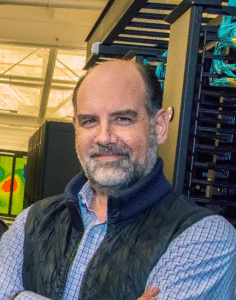Research in Kyrpides group focuses on Microbiome Data Science and analysis of Big Data.
Biology is currently experiencing a revolution brought on by rapid developments in genomics and other omics technologies. The exponential growth of DNA sequencing data, coupled with recent computational technology advances in management, processing and visualization of “big data,” and artificial Intelligent/machine learning approaches in data analysis and interpretation is creating new opportunities for breakthrough discoveries and catalyzing a major transition of biology into data science.
The research efforts of the group have concentrated in demonstrating the power of data science in tackling grand challenges in Biology, with a special focus on microbiome research. These efforts include exploration of the global diversity of alternative genetic codes (Science 2014), unearthing hundreds of thousands of new viral genomes and their predicted hosts (Nature 2016, Science 2017, Nature Microbiology 2018), discovery of new genes with important biotechnological applications (e.g., new CRISPR-Cas variants and new CRISPR-Cas types) (Nature Communications 2017, Science 2018, Molecular Cell 2019) and massive reconstruction of genomes from uncultivated microbes (Nature 2019).
Other projects in the group include the sequencing and comparative analysis of thousands of archaeal and bacterial type strains (GEBA-type strains project), the delineation of host-virus interactions, the exploration of the functional dark matter as well as the development of novel methods to enable large-scale comparative analysis, mining and visualization of big data.
Research Team
 |
 |
 |
 |
 |
|
| Nikos Kyrpides, PI | Antonio Camargo, Research Scientist |
Brayon Fremin, Project Scientist |
Eric Olo Ndela, Postdoctoral Fellow |
Mateus Fiamenghi, Postdoctoral Fellow |
Lee Call, Postdoctoral Fellow |
| [email protected] (925) 296-5718 |
[email protected] | [email protected] | [email protected] | [email protected] | [email protected] |
|
Antonio’s research is focusing on the development of new methods for the identification and classification of Mobile Genetic Elements from metagenomic data |
Brayon’s research is focusing on the identification of small proteins, structural RNAs and RNA viruses from metagenomic data. He is also studying global viral interaction networks
|
Eric’s research is focusing on the development of new computational approaches to identify and characterize novel Mobile Genetic Elements |
Mateus’s research is focusing on the identification and analysis of Mobile Genetic Elements from Metagenomic Data. |
Lee’s research focuses on large scale microbiome and virome data analysis |
Selected-Publications
- Pavlopoulos GA et al. (2023) Unraveling the functional dark matter through global metagenomics. Nature. 622(7983):594-602.
- Camargo AP. et al. (2023) Identification of mobile genetic elements with geNomad. Nat Biotechnol. Epub.
- Neri U. et al. (2022) Expansion of the global RNA virome reveals diverse clades of bacteriophages. Cell. 185(21):4023-4037
- Nayfach S, et al. (2021) Metagenomic compendium of 189,680 DNA viruses from the human gut microbiome. Nat Microbiol. 6(7):960-970.
- Nayfach S, et al. (2021) CheckV assesses the quality and completeness of metagenome-assembled viral genomes. Nature Biotechnol. 39(5):578-585.
- Nayfach S, et al. (2021) A genomic catalog of Earth’s microbiomes. Nature Biotechnol. 39(4):499-509.
- Danko D. et al. (2021) A global metagenomic map of urban microbiomes and antimicrobial resistance. Cell. 184(13):3376-3393
- Almeida A, et al. (2020) A unified catalog of 204,938 reference genomes from the human gut microbiome. Nature Biotechnol. 39(1):105-114.
- Schulz F, et al. (2020) Giant virus diversity and host interactions through global metagenomics. Nature 578(7795):432-436
- Sberro H, et al. (2019) Large-Scale Analyses of Human Microbiomes Reveal Thousands of Small, Novel Genes. Cell 178(5):1245-1259
- Nayfach S, et al, (2019) New insights from uncultivated genomes of the global human gut microbiome. Nature 568(7753):505-510
- Amann R. et al (2019) Toward unrestricted use of public genomic data. Science 363(6425):350-352
- Harrington LB, et al (2018) Programmed DNA destruction by miniature CRISPR-Cas14 enzymes. Science 362(6416):839-842.
- Duerkop BA, et al. (2018) Murine colitis reveals a disease-associated bacteriophage community. Nat Microbiol. 3(9):1023-1031
- Harrington LB et al. (2017) A thermostable Cas9 with increased lifetime in human plasma. Nat Commun. 8(1):1424.
- Sczyrba A, et al. (2017) Critical Assessment of Metagenome Interpretation-a benchmark of metagenomics software. Nature Methods 14(11):1063-1071
- Bowers RM, et al. (2017) Minimum information about a single amplified genome (MISAG) and a metagenome-assembled genome (MIMAG) of bacteria and archaea. Nature Biotechnology 35(8):725-731
- Mukherjee S, et al. (2017) 1,003 reference genomes of bacterial and archaeal isolates expand coverage of the tree of life. Nature Biotechnology 35(7):676-683
- Schulz F, et al. (2017) Giant viruses with an expanded complement of translation system components. Science 356: 82-85
- Ovchinnikov S. et al. (2017) Protein structure determination using metagenome sequence data. Science 355(6322):294-298
- Paez-Espino D. et al. (2017) IMG/VR: a database of cultured and uncultured DNA Viruses and retroviruses. Nucleic Acids Res. 45(D1):D457-D465.
- Paez-Espino, D. et al. (2016) Uncovering Earth’s virome. Nature 536:425-30
- Kyrpides NC. et al. (2016) Microbiome Data Science: Understanding Our Microbial Planet. Trends Microbiol. 24(6):425-7.
- Eloe-Fadrosh EA, et al. (2016) Metagenomics uncovers gaps in amplicon-based detection of microbial diversity. Nature Microbiol. 15032
- Eloe-Fadrosh EA, et al. (2016) Global metagenomic survey reveals a new bacterial candidate phylum in geothermal springs. Nature Commun. 7:10476
- Varghese NJ, et al. (2015) Microbial species delineation using whole genome sequences. Nucleic Acids Res. 43(14):6761-71
- Kyrpides NC et al. (2014) Genomic Encyclopedia of Bacteria and Archaea: Sequencing a Myriad of Type Strains. PLoS Biology 12(8):e1001920
- Ivanova N. et al. (2014) Stop Codon Reassignments in the Wild. Science 344(6186):909-13